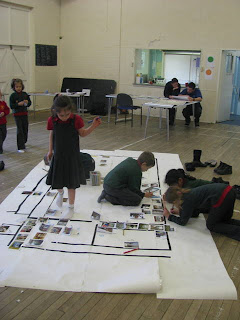
Michael Landy's Art Bin claims a rubbish Damien Hurst skull painting. Hooray! Tracey Emin also contributed, and my perception of them as people changes, if not as artists.
Got me thinking about rubbish, art, quality and value of art. Artists/ creative practitioners comment:
'You need to use quality arts materials to make good art.'
or
'To really value the work people do, you need to use quality materials'
I kind of understand where it's coming from. At Kings Heath Stay and Play we bought two sets of children's drums - one all cardboard and plastic, which sounded tinny got sat on and broke. The other was hardwaring, still sounds great but cost a lot.
However, working with rubbish can be exactly the quality you need. What's more, I think there is a satisfaction making art from rubbish, and even better from your own rubbish.
In 2005 I worked on CP project with Graham Langley, storyteller, and a secondary group from Quinton on Who are we. They were working with Graham creating a story from local placenames. I brought in a big bag of my rubbish, and together with some lentils and other bits we found in the room, we made the world in which the story happened. The model had quickly provided a few photos for backdrops, development of the story and their storytelling.
 It's a media I've used a fair bit over the years with much effect. I'm working with Shenley Green Youth & Community Centre at the moment, and as one of the activities we decided to recreate the community centre from rubbish. The group gradually extended their model to include much of their Shenley Green. The model was made from rubbish and was due to last shorter than the centre (demolition next week). We decided no one will put it into Landy's, or anyone else's skip. The model at least was rescued from demolition by the people who made it.
It's a media I've used a fair bit over the years with much effect. I'm working with Shenley Green Youth & Community Centre at the moment, and as one of the activities we decided to recreate the community centre from rubbish. The group gradually extended their model to include much of their Shenley Green. The model was made from rubbish and was due to last shorter than the centre (demolition next week). We decided no one will put it into Landy's, or anyone else's skip. The model at least was rescued from demolition by the people who made it.




















